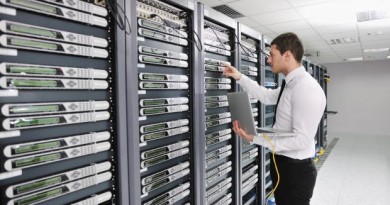What Surge Suppression Does Your Data Center Have?
A surge suppressor is also widely known as a surge protector. It is a device introduced to the alternating current (AC) utility line or telephone line to avoid break down of electronic equipment from voltage fluctuation. The spikes popularly called transients is what puts off the electricity. A suitable and more appropriate term for this kind of device is “transient suppressor.” A classical surge suppressor looks something like a small box with numerous utility outlets, a control switch, and a 3-wire cord for connecting to a wall outlet.
Transients that occur from various grounds, normally reach peak levels of numerous hundred volts. These high volts can cause hardware to malfunction. The most horrible kind of transient takes place when lightning strikes in the surrounding area (not essential for a power line to be directly hit). This type of spike will be able to peak at thousands of volts and result in enduring damage to equipment.
A surge suppressor is used prevent the peak AC voltage from reaching higher than a certain threshold (plus-or-minus 200 volts). Semiconductor devices are used for this reason. Surge suppressors have to be used as a matter of custom with all semiconductor-based electronic and system hardware. Computer hardware including peripherals such as printers, Mouse, monitors, external hard drives, and modems. However the suppressor must not be relied upon to supply shield against lightning induced transients. All susceptible hardware must be plugged into the suppressor box. Whenever the equipment is left in thunderstorm-prone area, it must be unplugged from the suppressor’s main power cord when the equipment is not in use.
Surge suppression products are ideally installed at service entrances and larger distribution panels. They limit the impact of both externally and internally produced high-voltage power spikes by fastening them to a suitable level. Despite the fact that they provide an immense first stage of protection from lower-level uproar surge, protection products do not guard susceptible equipment. It includes the low-voltage transients and noise. Surge suppression technology deals with those issues or trials that are far more ordinary than lightning strikes or other high-energy transients. Another reason why most data centers use power protection products is because they are an easy and cost effective way to safeguard electronic equipments from break down, downtime, or failure. Power filtering and surge protection products offer safety and sustained productivity for electronic processes. Protecting a facility with this parallel line is an outstanding first measure of security in bringing in uninterruptible power supply. It also limits the high impulse transients to a level that is suitable to most electronic equipment. These intense energy surge protection products are positioned in matching with panels that are inclined to both externally and internally engender transients. There are a wide range of surge suppressors that provide specific surge protection levels. They range from voltage or phase configurations, and any mode protection prerequisite at any panel within the facility the products are determined with.
Buying a surge protector is a complicated business because they are available in quite a number in the market. Research into a particular model is the best way to ensure good results regarding a purchase. It is important to understand what kind of a surge suppression the data center requires. This depends on the maximum voltage capacity the data center can handle. Although one can get an impression of a product’s performance level by checking for certain aspects but most importantly, the pricing!
As a rule of thumb, the least expensive ones may not be built to handle high voltage. This can result in unexpected disasters. However, high price doesn’t guarantee quality. To understand what the unit is capable of, it is important to check (UL) ratings. UL is an autonomous, not-for-profit concern that tests electric and electronic products for security. If a protector doesn’t have a UL listing, it’s probably an unreliable product; there’s a fairly good chance it doesn’t have any protection mechanism at all. Many UL-listed products are also of poorer quality of itinerary, but with the slightest certainty that they have some surge protection capabilities in comparison to the uncertified ones. It is essential ensure that the product is listed as a transient voltage surge suppressor. This means that it meets the standard for UL 1449, UL’s least performance standard for surge suppressors. There are a lot of power strips listed by UL that have no surge safety mechanism at all. They are listed only for their performance as extension cords. It’s only through thorough research one can be sure what surge suppression is good for the data center.
Data Center Talk updates its resources every day. Visit us to know of the latest technology and standards from the data center world.
Please leave your views and comments on DCT Forum

